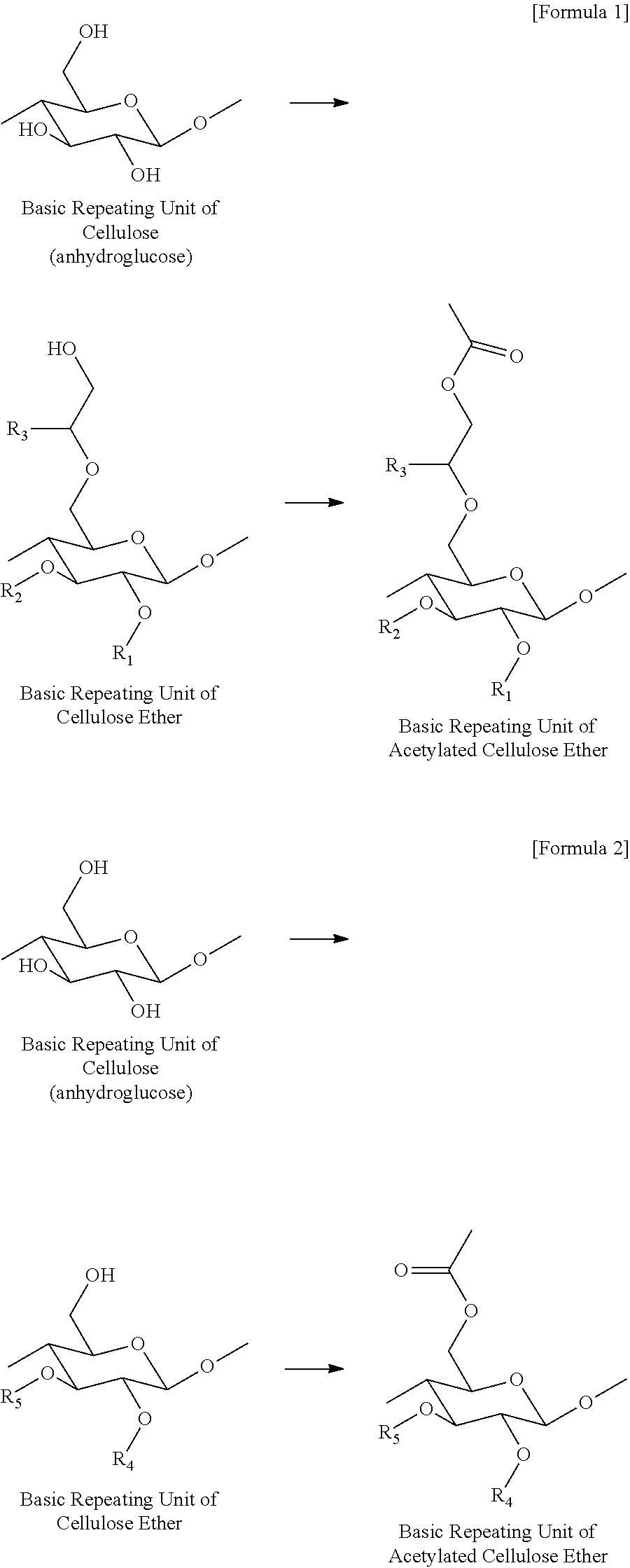Acetylated cellulose ether and articles including same
- Summary
- Abstract
- Description
- Claims
- Application Information
AI Technical Summary
Benefits of technology
Problems solved by technology
Method used
Image
Examples
Example
EXAMPLE
Examples 1-9
Preparation of Acetylated Cellulose Ether
[0035]200 g of cellulose ether, 1400 g of acetic acid, 300 g of sodium acetate, 600 g of acetic anhydride were added to a 3 L reactor equipped with a stirrer, and the mixture was heat-treated at 85° C. for 8 hours while stirring at 200 rpm to prepare acetylated cellulose ether. Here, acetic acid was used as a solvent, and sodium acetate was used as a catalyst. Then, the mixture in the reactor was coagulated by spraying it into an 18 L coagulating bath, washed 5 times with clean water, and dried. The DS of a methyl group, the MS of a hydroxyalkyl group, and the MS of a hydroxyethyl group of each of the cellulose ethers that were used in Examples 1 to 9, and the molar ratio of acetic anhydride used per anhydroglucose unit contained in each of the cellulose ethers are listed in Table 1 below.
TABLE 1cellulose etheraceticMS ofMS ofanhydride / DS ofhydroxy-hydroxy-anhydro-methylpropylethylglucose unitTypegroupgroupgroup(mole rati...
Example
Comparative Example 1
Preparation of Cellulose Triacetate (CTA)
[0036]CTA (Eastman A435-85) was prepared.
Example
Comparative Example 2
Preparation of Polyvinylidene Difluoride (PVDF)
[0037]PVDF (Kynar flex 761) was prepared.
Evaluation Example
[0038]Evaluation Example: Evaluation of Physical Properties of Acetylated Cellulose Ether
[0039]The DS of an acetyl group, contact angle with water, and tensile strength and / or molecular weight of each of the acetylated cellulose ethers prepared according to Examples 1 to 9, CTA of Comparative Example 1 and PVDF of Comparative Example 2 were measured using the methods below, and the results are listed in Table 2.
[0040](Measurement of DS of an Acetyl Group)
[0041]Free acetic acids generated by saponification of acetylated cellulose ether samples prepared according to Examples 1 to 9, and CTA of Comparative Example 1were titrated with an alkaline material to measure the DS of an acetyl group of each of the acetylated cellulose ethers (ASTM D871-96).
(Measurement of Contact Angle and Tensile Strength)
[0042]10 g of each sample of Examples 1 to 9 and Comparative Ex...
PUM
| Property | Measurement | Unit |
|---|---|---|
| Pressure | aaaaa | aaaaa |
| Mass | aaaaa | aaaaa |
| Contact angle | aaaaa | aaaaa |
Abstract
Description
Claims
Application Information
 Login to View More
Login to View More - R&D
- Intellectual Property
- Life Sciences
- Materials
- Tech Scout
- Unparalleled Data Quality
- Higher Quality Content
- 60% Fewer Hallucinations
Browse by: Latest US Patents, China's latest patents, Technical Efficacy Thesaurus, Application Domain, Technology Topic, Popular Technical Reports.
© 2025 PatSnap. All rights reserved.Legal|Privacy policy|Modern Slavery Act Transparency Statement|Sitemap|About US| Contact US: help@patsnap.com

